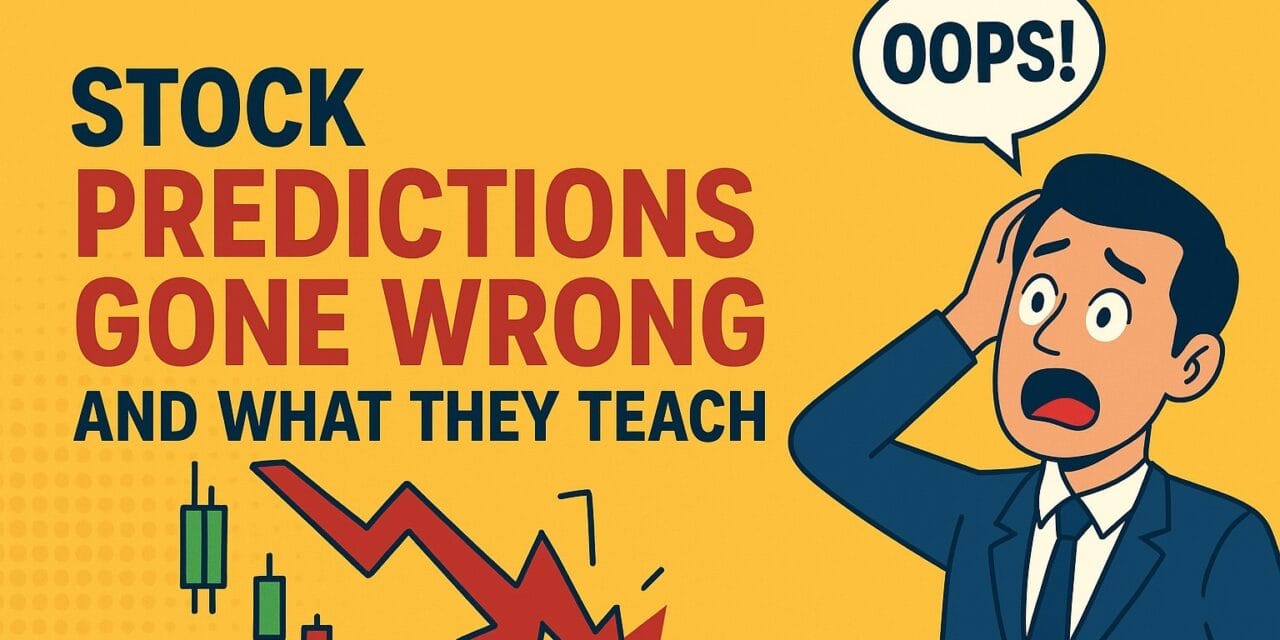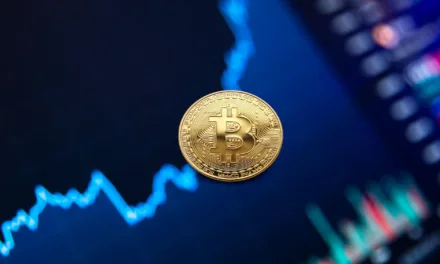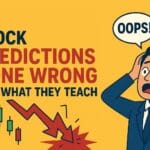In this post, we will look at 5 stock predictions gone terribly wrong and the lessons we can learn from them. But first, our disclosure:
Disclosure: This post may contain affiliate links, meaning we earn a commission on purchases made through those links at no extra cost to you. As an Amazon Associate, I earn from qualifying purchases.
Disclaimer: The content on this site is for informational and educational purposes only and does not constitute financial, investment, legal, tax, or any other professional advice and should not be used as a substitute for professional advice. For more details, read our full Disclaimer.
Stock Predictions Gone Wrong
Making predictions in the stock market has always been a risky game—even for so-called experts. Time and again, bold forecasts have gone spectacularly wrong. History is full of hilariously bad calls that aged worse than spoiled milk. In this post, we’ll look at 5 stock market predictions gone terribly wrong and, more importantly, the valuable lessons every investor can learn from these epic fails.
1. Jim Cramer’s Confidence In Bear Stearns
There is no better way to kick off this list than by starting with the one and only Jim Cramer. Odds are you know who he is, but for those that don’t, Jim Cramer is a former hedge fund manager and the longtime host of “Mad Money” on CNBC. He is known for his wild and entertaining persona on television, where he has been discussing stocks for over 20 years.
As you can imagine, after discussing stocks night after night for over twenty years, many stock predictions will inevitably turn out to be wrong. As such, Jim Cramer has earned a reputation for making poor stock predictions to the point that it has become a meme. One of his most notable predictions occurred during the Great Financial Crisis (GFC), involving Bear Stearns.
It all happened on March 11th, 2008. Someone wrote into “Mad Money” asking Jim Cramer if they should be concerned about Bear Stearns’ liquidity and whether they should take their money out. To which Jim Cramer replied:
“No, no, no! Bear Stearns is fine. Do not take your money…” before mumbling and trailing off. Moments later, he continued, “Bear Stearns is not in trouble. If anything, it will likely be taken over. Don’t move your money from Bear. That’s just being silly. Don’t be silly.” The only thing that turned out silly was his prediction.
Within days, Bear Stearns had collapsed and was acquired by JPMorgan Chase in a government-brokered fire sale. In its haste to contain the financial crisis, the Federal Reserve brokered a deal that saw JPMorgan Chase acquire Bear Stearns for only $10 per share. As bad as that number was, it could have been worse, as JPMorgan Chase’s first offer was for only $2 per share.
Key Stock Predictions Investing Lessons:
Don’t confuse entertainment with investing advice. When watching a financial TV show that features a stock-picking “Lightning Round,” where a host presses buttons to create silly sounds, remember that you are being entertained. While you might learn something from these programs, don’t base your investing decisions on a thirty-second sound bite.
Learn More
I highly recommend reading Too Big to Fail, by Andrew Ross Sorkin. It is an insider’s look at the 2008 financial crisis and the inner workings of Wall Street and the government during that time. Sorkin does a great job telling a gripping story of the banking industry on the verge of collapse, making it exciting and easy to read.
2. Steve Ballmer Laughs At The iPhone
Shortly before Jim Cramer was telling people Bear Stearns was fine, former Microsoft CEO Steve Ballmer was laughing at the iPhone.
The iPhone was first released back in 2007 at a time when the BlackBerry was the dominant phone. Steve Ballmer could not contain his laughter when asked about it. He poked fun at the iPhone, calling it too expensive at $500, a poor email device due to the lack of a physical keyboard, and not suitable for business customers. However, it is Apple that would ultimately have the last laugh.
Within a year of its launch, the iPhone outsold the BlackBerry and would go on to revolutionize how we conduct business. By the time Microsoft realized its colossal error in judgment, it was too late. The BlackBerry was on the way out, and Microsoft’s attempt at a smartphone, the Windows Phone, was a complete failure.
Today, BlackBerry is a mere shadow of its former self, primarily operating as a small software company. At its peak in 2008, the company’s stock price was over $130.00 per share. Since then, its stock price has collapsed, now trading at around $5 per share. That’s a 96% decrease!
Meanwhile, Apple has experienced tremendous growth and is now one of the world’s largest companies. Its stock price followed the success of the iPhone, surging from around $5 per share to over $250 per share by the end of September 2025. That’s an amazing 4,900% increase in stock value!
As for Microsoft, it has continued to achieve major success, despite missing out on the smartphone market. Today, the company ranks among the largest in the world, with a market cap comparable to that of Apple. However, there’s no denying how terribly wrong Steve Ballmer’s prediction about the iPhone turned out to be.
Key Stock Predictions Investing Lessons:
Change happens fast, and this is especially true when it comes to technology and the stock market. Remember, it only took the iPhone just over one year from its launch to displace the BlackBerry. Therefore, never let arrogance replace curiosity. Doing so can blind you to the potential of new investing opportunities.
3. Cathie Wood and Zoom $1,500
Cathie Wood is the founder of Ark Invest, an investment firm that specializes in actively managed exchange-traded funds (ETFs). Ark Invest focuses on disruptive and cutting-edge technologies, including robotics and artificial intelligence.
Wood is well-known for making bold stock predictions that often generate buzz in the investing world. However, many of Cathie Wood’s predictions have gone horribly wrong, with her price prediction for Zoom being one of her worst ones yet.
During the COVID-19 pandemic, Zoom Technologies greatly benefited from people being confined to their homes, with video calls becoming their primary option for interacting with others. As a result, Zoom’s stock price skyrocketed during the pandemic to over $500 per share before cooling off to around $100 per share in 2022.
In 2022, as the pandemic was winding down, Cathie Wood made one of her most famous and infamous predictions: she claimed that Zoom Technologies would reach $1,500 per share by 2026. More specifically, she provided three price targets, as she typically does: the bear case, the base case, and the bull case:
- Bear case: $700 per share
- Base case: $1,500 per share
- Bull case: $2,000 per share
Since Cathie Wood made her infamous prediction about Zoom’s stock, its price has declined and remained around $80 per share for nearly four years. That is far below the $1,500 she predicted. If someone invested in Zoom based on her prediction, they would have experienced a loss of around 20% during this period. In contrast, the S&P 500 gained approximately 100% over the same time frame, resulting in a gross loss of 120% when comparing Zoom’s performance to that of the index.
Talk about terrible stock predictions! As you can probably guess, Cathie Wood and Ark Invest no longer hold a position in the company.
Key Stock Predictions Investing Lessons:
Don’t assume that trends will last. During the pandemic, many people believed the world would never return to its pre-COVID-19 state. Night after night, we heard the same tired cliché: “This time it’s different.” While there certainly were changes, at our core, humans are social creatures who crave direct interactions. Zoom could not replace that need. Cathie Wood bet it could and lost.
4. Whitney Tilson Calling Google Stock Overhyped
In 2004, just a few years after the dot-com bubble burst, Google held its initial public offering (IPO). At that time, many prominent business figures, including Steve Ballmer, were skeptical about Google’s potential for success (how many times can he be wrong?). However, the person who stands out the most is Whitney Tilson.
Whitney Tilson is a former hedge fund manager and, most recently, a former mayoral candidate in New York City. However, what he might be most famous for is just how horribly wrong he was about Google.
Writing for The Motley Fool in 2004, Tilson compared Google to Dell, predicting that Dell had an 80%-90% chance of remaining a major computer company in 20 years, while he believed Google would fade away.
Tilson acknowledged his admiration for Google and its achievements in search. However, he went on to write: “… I am quite certain that there is only a fairly shallow, narrow moat around its business.”
To make matters worse, Tilson dismissed Google’s valuation, comparing it to that of McDonald’s, writing: “Google with the same market cap as McDonald’s (a stock I own)?! HA!”
Whitney Tilson later made what might arguably be the most cringeworthy stock prediction ever when he wrote:
“I believe that it is virtually certain that Google’s stock will be highly disappointing to investors foolish enough to participate in its overhyped offering — you can hold me to that.” We all know what happened next.
Google went on to trounce Dell and McDonald’s, with its stock increasing by over 7,000% since its IPO. Over time, it evolved beyond just a search engine, which led to its rebranding as Alphabet to reflect the diverse range of businesses it owns. Today, it is a multi-trillion-dollar company and one of the largest in the world.
Key Stock Predictions Investing Lessons:
Having lived through the dot-com bubble, I understand Whitney Tilson’s reservations about investing in Google’s IPO. During the dot-com bubble, investors were burned by internet companies that had sky-high valuations but generated little to no revenue. The focus on recent events when making investment decisions is known as recency bias.
Recency bias is one of many cognitive biases that influence our investment decisions. Other biases include confirmation bias, overconfidence bias, hindsight bias, and loss aversion, among others. The key challenge is not whether we have these biases, but how we can overcome them to become better investors. Being aware of them is half the battle.
I strongly recommend the following books to learn more about how our behavior and biases impact our investment decisions:
- The Little Book of Behavioral Investing by James Montier
- Thinking, Fast and Slow by Daniel Kahneman
5. Harry Dent: The Sky Is Falling On Stocks
We conclude this list of terrible stock predictions with Harry Dent. Harry Dent is an economist and author, and might possibly be the worst stock market predictor of all time. His claim to fame is correctly predicting a few market trends in the late 1980s and 1990s. However, even a broken clock is right twice a day. Since then, it has been all downhill for Harry Dent.
In his 1999 book, The Roaring 2000s, Dent predicted that the stock market would reach 35,000 by the end of the decade. Instead, this period became known as the “Lost Decade,” during which the Dow Jones Industrial Average started around 11,000 in 2000 and ended roughly at the same level in 2010.
Despite his incorrect predictions about the 2000s, Dent published another book in 2008 titled The Great Depression Ahead. He released his book at the peak of the Great Recession. Rather than another Great Depression, 2008 marked the beginning of one of the longest bull markets in history.
You would think at this point he would stop making stock market predictions, but that is not the case.
Harry Dent’s Terrible Stock Market Predictions
In March 2021, he predicted a 45% drop in the S&P 500 by June of the same year. Instead, it closed near a record high. Undeterred, Harry Dent went on to predict an 80% drop by Thanksgiving. Not only did the S&P 500 not drop by 80%, but it also went on to reach new highs and returned an impressive 26.89% in 2021.
You would think Harry Dent would give up on the prediction game, but he is still at it. More recently, Harry Dent predicted that the S&P 500 would drop 86% in 2024. Wrong again! It gained 25% that year. However, it gets better with his latest stock prediction for Nvidia.
Dent’s Nvidia Stock Prediction
In 2024, Harry Dent predicted that Nvidia’s stock would drop by 98%. This is a multi-trillion-dollar company experiencing year-over-year revenue growth exceeding 100%, with nearly $60 billion in cash and little debt. Despite these strong fundamentals, Dent believes the company’s stock will crash by 98%. So far, rather than crashing, Nvidia stock has gained over 170% in 2024 and is up more than 40% so far in 2025.
Key Stock Predictions Investing Lessons:
Be wary of “experts” making outlandish stock predictions. Big attention-grabbing predictions make for great headlines, but they don’t make for sound investing advice. Permabears, like Harry Dent, are notorious for sparking emotional reactions to garner attention and engagement. The same is true for those who overhype a stock.
Remember, just because panic sells doesn’t mean you have to buy it—and just because someone’s pumping a stock doesn’t mean your dollars should inflate it. Smart money moves with reason, not emotion.
Conclusion: Terrible Stock Predictions and the Ultimate Lesson
We explored several examples of stock predictions that went horribly wrong and the investing lessons we can learn from them. However, they all share one major investing lesson.
From Jim Cramer defending Bear Stearns just before its collapse to Harry Dent forecasting another Great Depression right before one of the longest bull markets in history, one lesson stands out above all others: no one can predict the future. Not your neighbor, not someone on social media, and not even the experts.
History shows that no one, regardless of their expertise or popularity, can consistently predict market movements. As you navigate your investing journey, remember to question bold claims and predictions. Instead, focus on thorough research and sound investment strategies, and always remember that the future is inherently unpredictable. Be careful of anyone who claims otherwise.











